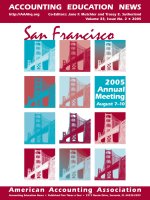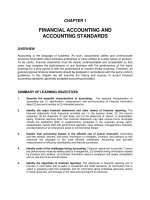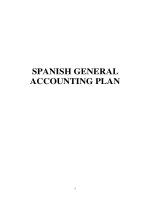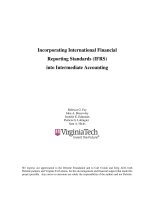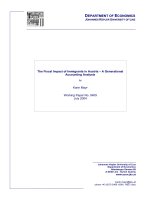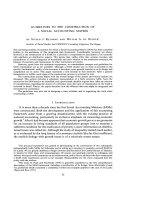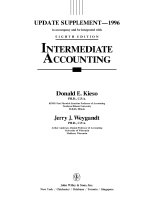Intermediate Accounting - Chap003 ppt
Bạn đang xem bản rút gọn của tài liệu. Xem và tải ngay bản đầy đủ của tài liệu tại đây (527.09 KB, 38 trang )
Copyright © 2007 by The McGraw-Hill Companies, Inc. All rights reserved.
The Balance
Sheet and
Financial
Disclosures
3
3-2
Learning Objectives
Describe the purpose of the balance sheet and
understand its usefulness and limitations.
3-3
The Balance Sheet
Limitations:
The balance sheet does not
portray the market value of
the entity as a going concern
nor its liquidation value.
Resources such as
employee skills and
reputation are not recorded
in the balance sheet.
Limitations:
The balance sheet does not
portray the market value of
the entity as a going concern
nor its liquidation value.
Resources such as
employee skills and
reputation are not recorded
in the balance sheet.
Usefulness:
The balance sheet describes
many of the resources a
company has available for
generating future cash flows.
It provides liquidity
information useful in
assessing a company’s
ability to pay its current
obligations.
It provides long-term
solvency information relating
to the riskiness of a
company with regard to the
amount of liabilities in its
capital structure.
Usefulness:
The balance sheet describes
many of the resources a
company has available for
generating future cash flows.
It provides liquidity
information useful in
assessing a company’s
ability to pay its current
obligations.
It provides long-term
solvency information relating
to the riskiness of a
company with regard to the
amount of liabilities in its
capital structure.
The purpose of the balance sheet is to report a
company’s financial position on a particular date.
3-4
Resources
(Assets)
Resources
(Assets)
Claims against
resources (Liabilities)
Claims against
resources (Liabilities)
Remaining claims
accruing to owners
(Owners’ Equity)
Remaining claims
accruing to owners
(Owners’ Equity)
Balance Sheet
3-5
Learning Objectives
Distinguish between current and noncurrent
assets and liabilities.
Identify and describe the various balance
sheet asset classifications.
3-6
(In millions) 2004 2003
Assets:
Current assets:
Cash and cash equivalents 1,046$ 538$
Receivables, less allowances 3,027 2,627
Spare parts, supplies, and fuel 249 228
Deferred income taxes 489 416
Prepaid expenses and other 159 132
Total current assets 4,970$ 3,941$
Property and equipment, at cost:
Aircraft and related equipment 7,001$ 6,624$
Package handling & ground support
equipment and vehicles 5,296 5,013
Computer & electronic equipment 3,537 3,180
Other 4,477 4,200
20,311 19,017
Less accumulated depreciation 11,274 10,317
Net property and equipment 9,037 8,700
Other long-term assets:
Goodwill 2,802 1,063
Prepaid pension cost 1,127 1,269
Intangible and other assets 1,198 412
Total other long-term assets 5,127 2,744
Total Assets 19,134$ 15,385$
FedEx Corporation
Balance Sheet
31-May
Assets are
probable
future
economic
benefits
obtained or
controlled by
a particular
entity as a
result of past
transactions
or events.
Assets are
probable
future
economic
benefits
obtained or
controlled by
a particular
entity as a
result of past
transactions
or events.
3-7
Cash
Cash
Cash Equivalents
Cash Equivalents
Short-term Investments
Short-term Investments
Receivables
Receivables
Inventories
Inventories
Prepayments
Prepayments
Cash
Cash
Cash Equivalents
Cash Equivalents
Short-term Investments
Short-term Investments
Receivables
Receivables
Inventories
Inventories
Prepayments
Prepayments
Current Assets
Will be converted
Will be converted
to cash or
to cash or
consumed within
consumed within
one year or the
one year or the
operating cycle,
operating cycle,
whichever is
whichever is
longer.
longer.
Will be converted
Will be converted
to cash or
to cash or
consumed within
consumed within
one year or the
one year or the
operating cycle,
operating cycle,
whichever is
whichever is
longer.
longer.
Current
Current
Assets
Assets
Current
Current
Assets
Assets
Cash equivalents
include certain
negotiable items such
as commercial paper,
money market funds,
and U.S. treasury bills.
3-8
Current Assets
Will be converted
Will be converted
to cash or
to cash or
consumed within
consumed within
one year or the
one year or the
operating cycle,
operating cycle,
whichever is
whichever is
longer.
longer.
Will be converted
Will be converted
to cash or
to cash or
consumed within
consumed within
one year or the
one year or the
operating cycle,
operating cycle,
whichever is
whichever is
longer.
longer.
Cash that is restricted
for a special purpose
and not available for
current operations
should not be
classified as a current
asset.
Cash
Cash
Cash Equivalents
Cash Equivalents
Short-term Investments
Short-term Investments
Receivables
Receivables
Inventories
Inventories
Prepayments
Prepayments
Cash
Cash
Cash Equivalents
Cash Equivalents
Short-term Investments
Short-term Investments
Receivables
Receivables
Inventories
Inventories
Prepayments
Prepayments
Current
Current
Assets
Assets
Current
Current
Assets
Assets
3-9
Operating Cycle of a Typical Manufacturing
Company
Use cash to acquire raw materials
Convert raw materials to finished
product
Deliver product to customer
Collect cash from customer
3-10
Noncurrent Assets
Investments and
Investments and
Funds
Funds
Property, Plant, &
Property, Plant, &
Equipment
Equipment
Intangibles
Intangibles
Other
Other
Investments and
Investments and
Funds
Funds
Property, Plant, &
Property, Plant, &
Equipment
Equipment
Intangibles
Intangibles
Other
Other
Not expected to
Not expected to
be converted to
be converted to
cash or
cash or
consumed within
consumed within
one year or the
one year or the
operating cycle,
operating cycle,
whichever is
whichever is
longer
longer
Not expected to
Not expected to
be converted to
be converted to
cash or
cash or
consumed within
consumed within
one year or the
one year or the
operating cycle,
operating cycle,
whichever is
whichever is
longer
longer
Noncurrent
Noncurrent
Assets
Assets
Noncurrent
Noncurrent
Assets
Assets
3-11
Noncurrent Assets
Other Assets
1. Includes long-term prepaid
expenses and any noncurrent
assets not falling in one of the
other classifications
Investments and Funds
1. Not used in the operations of the
business
2. Includes both debt and equity securities
of other corporations, land held for
speculation, noncurrent receivables, and
cash set aside for special purposes
Property, Plant and Equipment
1. Are tangible, long-lived, and used in the
operations of the business
2. Includes land, buildings, equipment,
machinery, and furniture as well as
natural resources such as mineral mines,
timber tracts, and oil wells
3. Reported at original cost less
accumulated depreciation (or depletion
for natural resources)
Intangible Assets
1. Used in the operations of the
business but have no physical
substance
2. Includes patents, copyrights, and
franchises
3. Reported net of accumulated
amortization
©
3-12
Learning Objectives
Identify and describe the two balance sheet
liability classifications.
3-13
(In milions) 2004 2003
Liabilities:
Current liabilities:
Current portion of long-term debt 750$ 308$
Accrued salaries & employee benefits 1,062 724
Accounts payable
1,615 1,168
Accrued expenses 1,305 1,135
Total current liabilities 4,732 3,335
Long-term debt, less current portion 2,837 1,709
Other long-term liabilities
Deferred income taxes 1,181 882
768 657
Self-insurance accruals 591 536
Deferred lease obligations 503 466
426 455
Other liabilities 60 57
Total other long-term liabilities 3,529 3,053
Total liabilities 11,098 8,097
Deferred gains, principally related to
aircraft transactions
FedEx Corporation
Balance Sheet
31-May
Pension, postretirement healthcare
and other benefit obligations
Liabilities are
probable
future
sacrifices of
economic
benefits
arising from
present
obligations of
a particular
entity to
transfer
assets or
provide
services to
other entities
as a result of
past
transactions
or events.
Liabilities are
probable
future
sacrifices of
economic
benefits
arising from
present
obligations of
a particular
entity to
transfer
assets or
provide
services to
other entities
as a result of
past
transactions
or events.
3-14
Current Liabilities
Accounts Payable
Notes Payable
Accrued Liabilities
Current Maturities
of Long-Term Debt
Accounts Payable
Notes Payable
Accrued Liabilities
Current Maturities
of Long-Term Debt
Obligations expected to be
satisfied through current
assets or creation of other
current liabilities within one
year or the operating cycle,
whichever is longer
Obligations expected to be
satisfied through current
assets or creation of other
current liabilities within one
year or the operating cycle,
whichever is longer
Current
Liabilities
Current
Liabilities
3-15
Long-term Liabilities
Notes Payable
Mortgages
Bonds Payable
Pension Obligations
Lease Obligations
Notes Payable
Mortgages
Bonds Payable
Pension Obligations
Lease Obligations
Obligations that
will not be
satisfied within
one year or
operating cycle,
whichever is
longer
Obligations that
will not be
satisfied within
one year or
operating cycle,
whichever is
longer
Long-Term
Liabilities
Long-Term
Liabilities
3-16
(In millions, except shares) 2004 2003
Common Stockholders' Investment:
Common stock, $.10 par value, 800 million
shares authorized, 300 million shares
issued for 2004 and 299 million shares 30$ 30$
issued for 2003
Additional paid-in capital 1,079 1,088
Retained earnings 7,001 6,250
Accumulated other comprehensive loss (46) (30)
8,064 7,338
Less deferred compensation and treasury
stock at cost 28 50
Total common stockholders' investment 8,036$ 7,288$
FedEx Corporation
Balance Sheet
31-May
Shareholders’ Equity is the residual interest in the
assets of an entity that remains after deducting
liabilities.
Shareholders’ Equity is the residual interest in the
assets of an entity that remains after deducting
liabilities.
3-17
Shareholders’ Equity
Capital
Stock
Capital
Stock
Retained
Earnings
Retained
Earnings
Treasury
Stock
Treasury
Stock
Deferred
Compensation
Deferred
Compensation
Accumulated Other Comprehensive Income
Accumulated Other Comprehensive Income
3-18
Learning Objectives
Explain the purpose of financial statement
disclosures.
3-19
Disclosure Notes
Summary of
Significant
Accounting Policies
Conveys valuable information
about the company’s choices from
among various alternative
accounting methods.
Subsequent Events
A significant development that
takes place after the company’s
fiscal year-end but before the
financial statements are issued.
Noteworthy Events
and Transactions
Transactions or events that are
potentially important to evaluating
a company’s financial statements,
e.g., related parties, errors and
irregularities, and illegal acts.
3-20
Learning Objectives
Explain the purpose of management’s
discussion and analysis.
3-21
Management Discussion and Analysis
Provides a biased but
Provides a biased but
informed perspective of
informed perspective of
a company’s operations,
a company’s operations,
liquidity, and capital
liquidity, and capital
resources.
resources.
Provides a biased but
Provides a biased but
informed perspective of
informed perspective of
a company’s operations,
a company’s operations,
liquidity, and capital
liquidity, and capital
resources.
resources.
3-22
Management’s Responsibilities
Preparing the financial
statements and other
information in the
annual report.
Maintaining and
assessing the
company’s internal
control procedures.
3-23
Learning Objectives
Explain the purpose of an audit and describe
the content of the audit report.
3-24
Auditors’ Report
Expresses the auditors’ opinion
as to the fairness of
presentation of the financial
statements in conformity with
generally accepted accounting
principles
Must comply with specifications
of the AICPA and the PCAOB
3-25
Auditors’ Opinions
Unqualified
Issued when the financial
statements present fairly the
financial position, results of
operations, and cash flows in
conformity with GAAP
Qualified
Issued when there is an exception
that is not of sufficient seriousness
to invalidate the financial
statements as a whole
Adverse
Issued when the exceptions are so
serious that a qualified opinion is
not justified
Disclaimer
Issued when insufficient
information has been gathered to
express an opinion
